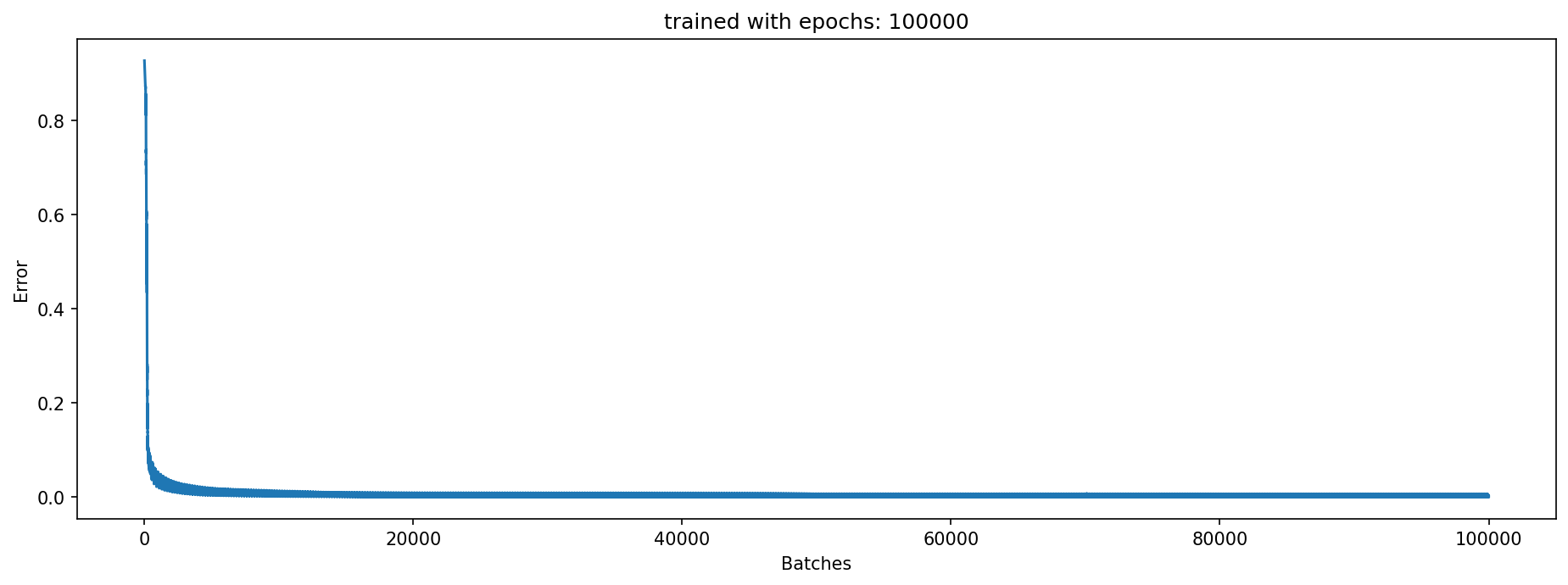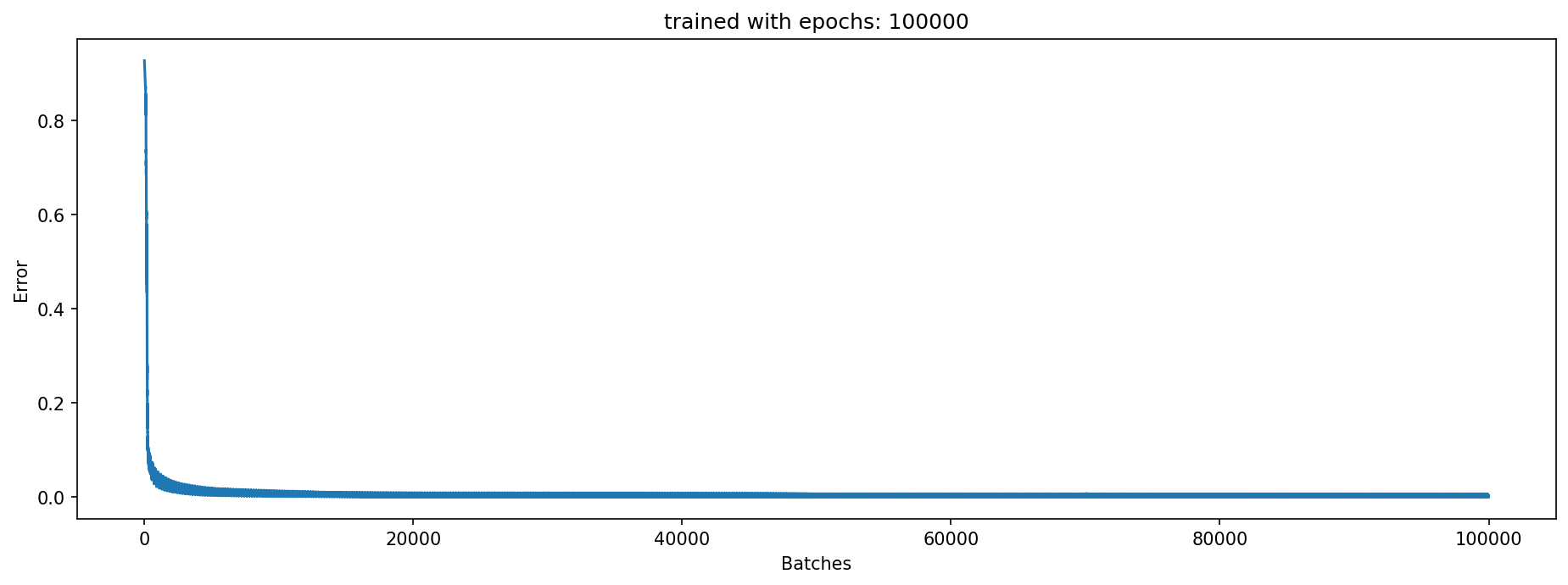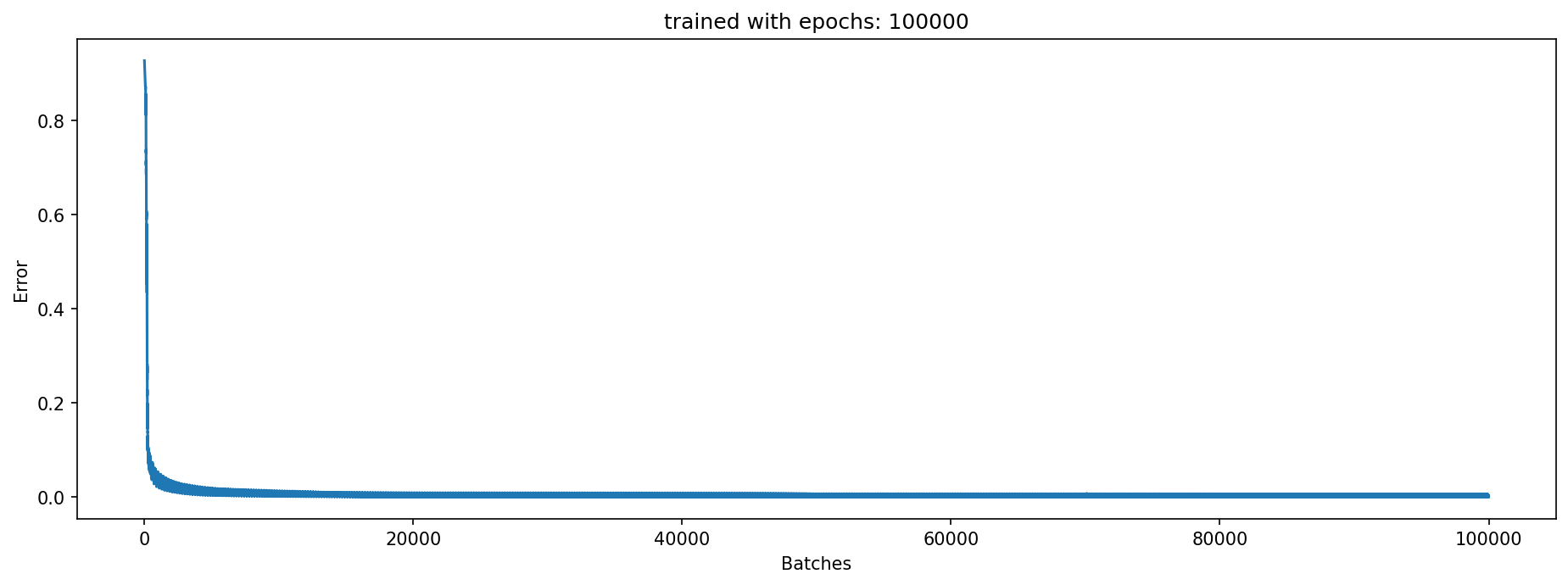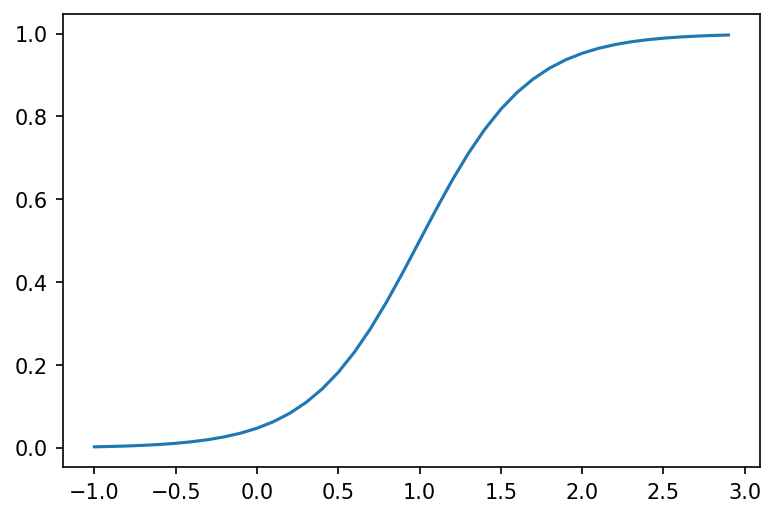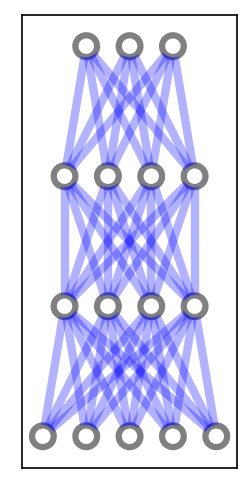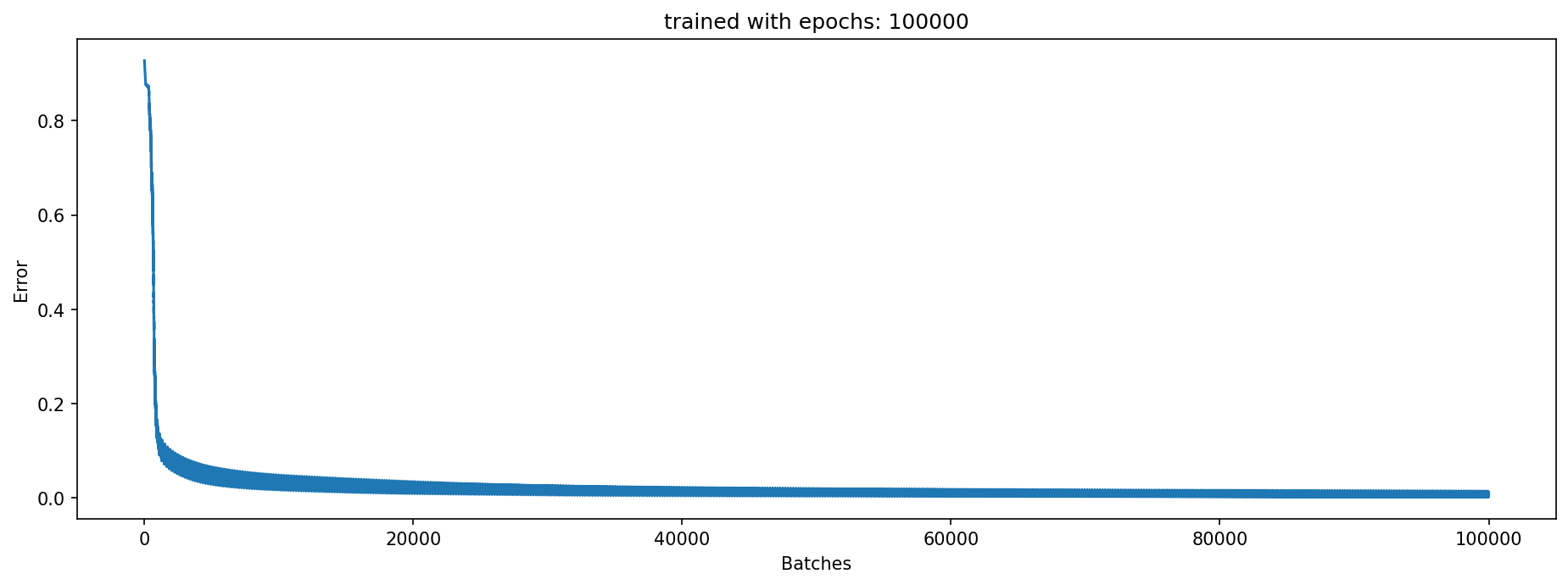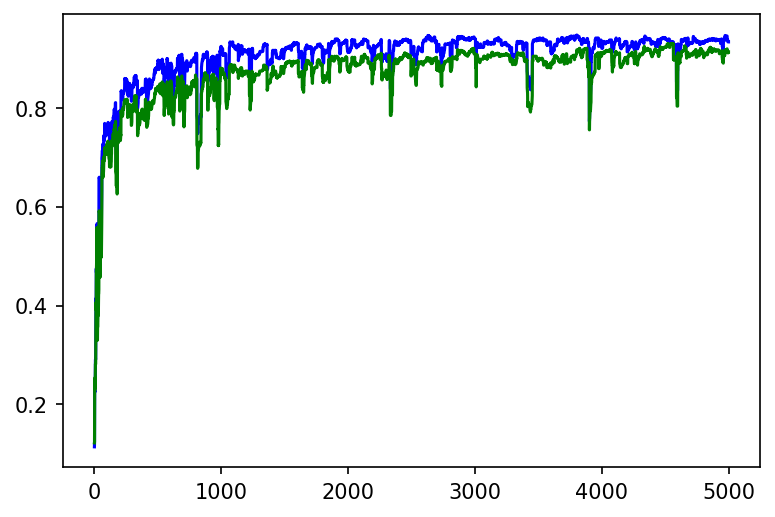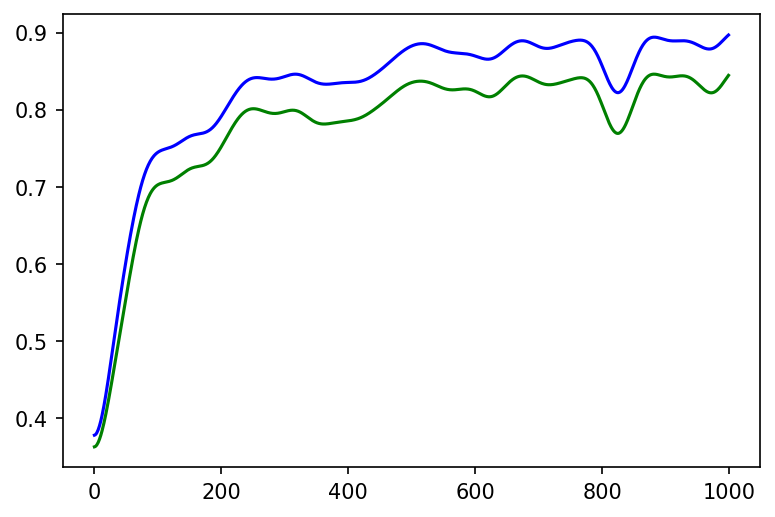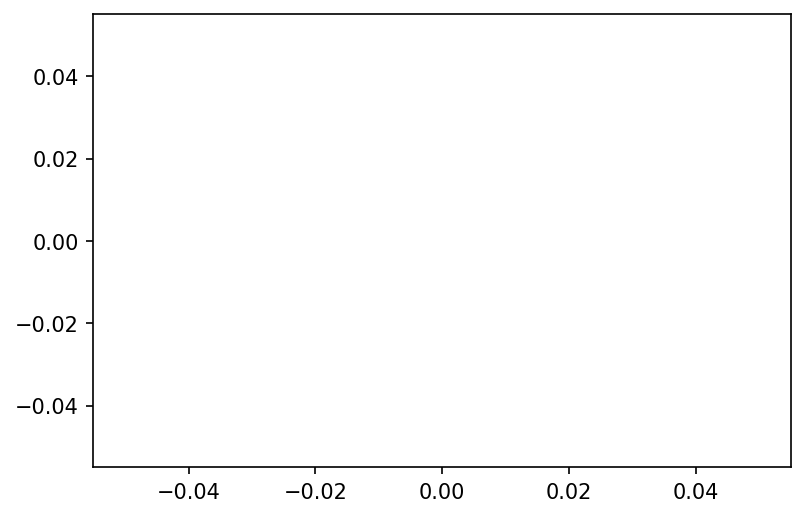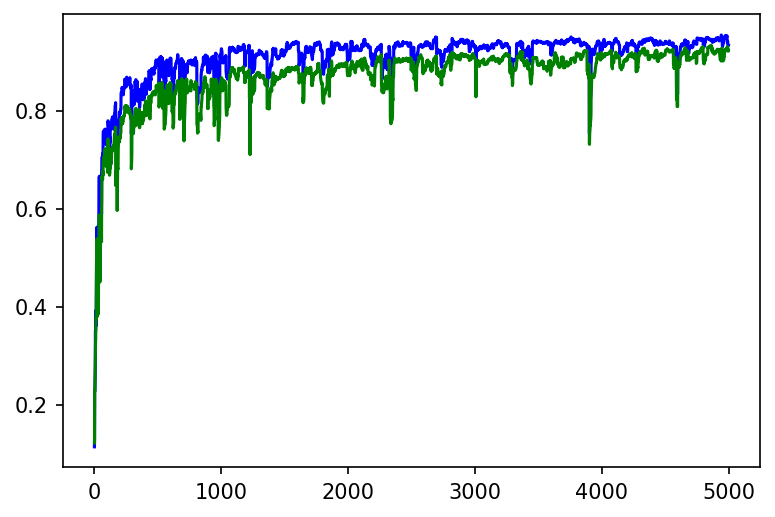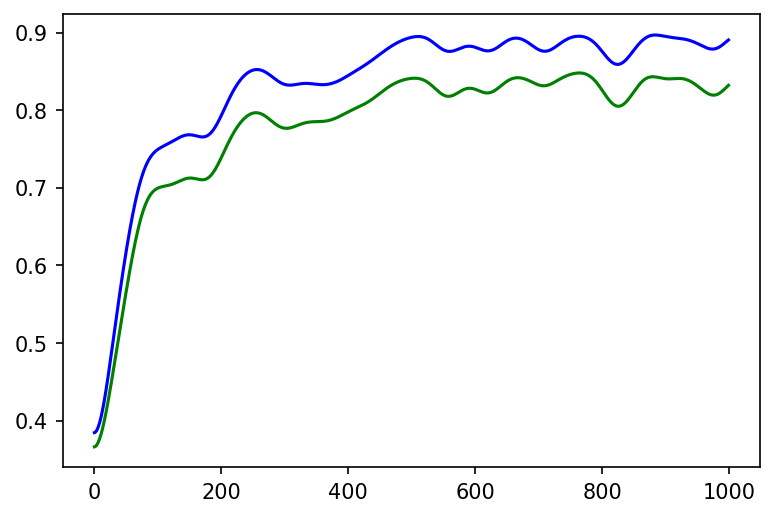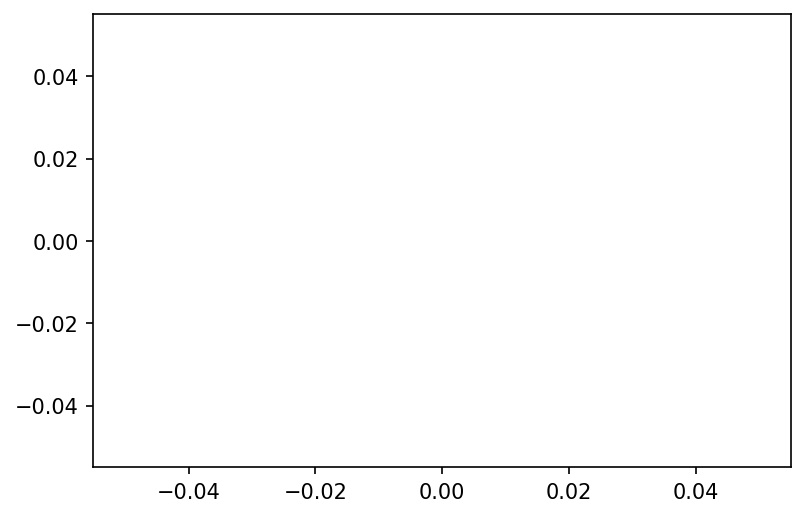We use the EMNIST dataset of handwritten digits to test a simple approach for few shot learning. Choosing a fully connected net with inputs and layer outputs between 0 and 1 and no bias parameters we first trained the network with a subset of the digits. The pre-trained net is used for few shot learning with the untrained digits. Two basic idea were necessary: first the training of the first layer was disabled (or very slow) during few shot learning, and second using a shot consists of one untrained digit together with four previously trained digits and perform a training up to a predefined threshold. This way we reach a 90% accuracy for all handwritten digits after 10 shots.
This jupyter notebook contains the generation of the tabels and images in the pdf: few_shot_paper.pdf
%%writefile _code_.py ↔Overwriting _code_.py
#!/usr/bin/env python3
# -*- coding: utf-8 -*-
"""
based on: https://towardsdatascience.com/inroduction-to-neural-networks-in-python-7e0b422e6c24
and https://stackoverflow.com/questions/29888233/how-to-visualize-a-neural-network/29889993
and https://towardsdatascience.com/how-to-build-your-own-neural-network-from-scratch-in-python-68998a08e4f6
and https://www.python-course.eu/neural_network_mnist.php
Created on Sun Jul 19 15:45:02 2020
@author: detlef
INSTALLATION:
use it within anaconda and install cupy if cuda availible
you will need https://www.python-course.eu/data/mnist/mnist_train.csv and https://www.python-course.eu/data/mnist/mnist_test.csv (mnist in csv) in the data/mnist subdirectory
emnist not in anaconda at the moment, use pip install emnist
on Google Colab (turn on GPU!!)
!curl https://colab.chainer.org/install | sh -
!pip install emnist
REMARKS:
loss function used = 1/2 SUM(error**2) // making the derivative error
"""
import cupy as np # helps with the math (Cuda supported: faster for hidden_size > 256 probably and most mnist cases with batch training)
#import numpy as np # helps with the math (if no Cuda is availible or size is small for simple tests)
from matplotlib import pyplot
from math import cos, sin, atan
import random
import pickle
from datetime import datetime
from tqdm import tqdm
from emnist import extract_training_samples, extract_test_samples
def np_array(x):
return np.array(x)# , dtype = np.float32) # float32 is 3 times faster on batch training with GTX1070Ti and 70 times faster than i7-4790K with float64, cpu does not help float32 a lot)
check_for_nan = True
pyplot.rcParams['figure.dpi'] = 150
pyplot.interactive(False) # seems not to fix memory issue
verbose = 0
do_check_all = 0 #1000 # 0 to turn off
check_output_limit = 128 # number of output combinations, as not every neural net is capable of learning input 0 0 0 -> output 1, if 128 the output to the first input is always 0
multi_test = -1 #1000 # -1 to turn off
max_iter = 30
hidden_size = 64
two_hidden_layers = True
use_bias = False
lr = 2
lr_few_shot = 0.5
use_stability = False
stability_mean = 0.1
clip_weights = 1 # (clipping to 1 was used for most tests)
clip_bias = 1
init_rand_ampl = 0.1
init_rand_ampl0 = 0.1 #2 # for first layer (2 was used for most tests to make the first layer a mostly random layer)
# drawing parameters
scale_linewidth = 0.1
weight_tanh_scale = 0.1
scale_for_neuron_diff = 1
scale_sigmoid = 3
shift_sigmoid = 1
few_shot_end = 0.2 # for early tests (no mnist)
few_shot_max_try = 100
few_shot_threshold_ratio = 1.5 # for mnist
few_shot_threshold = 0.3
# if 1 it is standard understanding of few shot learning, giving on data point at each shot, otherwize it adds more data points from availible training data to each shot
few_shot_more_at_once = 5
check_wrong = True
all_labels = [0, 1, 9, 3, 4, 5, 6, 7, 8, 2]
# random.shuffle(all_labels) # if shuffeld, preloading can not work !!!!!
try_load_pretrained = False
few_shot_fast_load_num = 4000 # should also handle the batch_sizes for displaying batch training results properly
test_from_random_input = False
i_bits = 16
# input data
inputs = np_array([[0, 0, 0],
[0, 0, 1],
[0, 1, 0],
[0, 1, 1],
[1, 0, 0],
[1, 0, 1],
[1, 1, 0],
[1, 1, 1]])
# output data
outputs = np_array([[0], [0], [1], [0], [1], [1], [0], [1]])
# swith to tanh and making input and output 1 -1 instead of 1 0
do_pm = False
use_emnist = True
load_mnist = True
do_batch_training = 100000
do_drop_weights = [] # [0.9,0.9]
initial_net_first_layer_slow_learning = 1 # 0.1 # most tests are done with 0.1 here, just try if it was really necessary
first_n_to_use = 600000
label_to_one = 5
num_outputs = 10 # most early test need this to be 1, later with mnist dataset this can be set to 10 eg.
try_mnist_few_shot = 10
use_every_shot_n_times = 1 # every data is used n times. so one shot means the data from first shot is used n times
change_first_layers_slow_learning = [0, 1] # [0, 0.1]
disable_progressbar = False
# uncomment to run in jupyter notebook
%run -i _code_.py Special few shot configuration, using additional data in every shot. Not the standard understanding of few shot!!!
labels (last two are used for few_shot) [0, 1, 9, 3, 4, 5, 6, 7, 8, 2]
0%| | 0/100000 [00:00<?, ?it/s]
start 18:21:24
Err 0.002: 100%|██████████| 100000/100000 [1:18:19<00:00, 21.28it/s]
end 19:39:44
train 192000 batch_size 1000 correct 999.0 of 1000 Ratio 0.999 Error 0.0020608174511465515
test 4000 batch_size 1000 correct 989.0 of 1000 Ratio 0.989 Error 0.01950864256808672
Testing if new lables were not learned !!!!!!!!!
new 4000 batch_size 1000 correct 0.0 of 1000 Ratio 0.0 Error 1.6566784770753793
few shot accuracy results
shot try old labels new labels new labels (forced) over all
1 1 0.895 0.492 0.776 0.815
2 1 0.952 0.574 0.754 0.879
3 1 0.950 0.521 0.667 0.870
4 1 0.960 0.535 0.730 0.878
5 1 0.856 0.621 0.677 0.818
6 1 0.961 0.708 0.839 0.905
7 1 0.958 0.666 0.806 0.900
8 1 0.949 0.747 0.844 0.911
9 1 0.954 0.811 0.918 0.923
10 1 0.926 0.836 0.919 0.908
<div class="burk">
#!/usr/bin/env python3
# -*- coding: utf-8 -*-
"""
based on: https://towardsdatascience.com/inroduction-to-neural-networks-in-python-7e0b422e6c24
and https://stackoverflow.com/questions/29888233/how-to-visualize-a-neural-network/29889993
and https://towardsdatascience.com/how-to-build-your-own-neural-network-from-scratch-in-python-68998a08e4f6
and https://www.python-course.eu/neural_network_mnist.php
Created on Sun Jul 19 15:45:02 2020
@author: detlef
INSTALLATION:
use it within anaconda and install cupy if cuda availible
you will need https://www.python-course.eu/data/mnist/mnist_train.csv and https://www.python-course.eu/data/mnist/mnist_test.csv (mnist in csv) in the data/mnist subdirectory
emnist not in anaconda at the moment, use pip install emnist
on Google Colab (turn on GPU!!)
!curl https://colab.chainer.org/install | sh -
!pip install emnist
REMARKS:
loss function used = 1/2 SUM(error**2) // making the derivative error
"""
import cupy as np # helps with the math (Cuda supported: faster for hidden_size > 256 probably and most mnist cases with batch training)
#import numpy as np # helps with the math (if no Cuda is availible or size is small for simple tests)
from matplotlib import pyplot
from math import cos, sin, atan
import random
import pickle
from datetime import datetime
from tqdm import tqdm
from emnist import extract_training_samples, extract_test_samples
def np_array(x):
return np.array(x)# , dtype = np.float32) # float32 is 3 times faster on batch training with GTX1070Ti and 70 times faster than i7-4790K with float64, cpu does not help float32 a lot)
check_for_nan = True
pyplot.rcParams['figure.dpi'] = 150
pyplot.interactive(False) # seems not to fix memory issue
verbose = 0
do_check_all = 0 #1000 # 0 to turn off
check_output_limit = 128 # number of output combinations, as not every neural net is capable of learning input 0 0 0 -> output 1, if 128 the output to the first input is always 0
multi_test = -1 #1000 # -1 to turn off
max_iter = 30
hidden_size = 64
two_hidden_layers = True
use_bias = False
lr = 2
lr_few_shot = 0.5
use_stability = False
stability_mean = 0.1
clip_weights = 1 # (clipping to 1 was used for most tests)
clip_bias = 1
init_rand_ampl = 0.1
init_rand_ampl0 = 0.1 #2 # for first layer (2 was used for most tests to make the first layer a mostly random layer)
# drawing parameters
scale_linewidth = 0.1
weight_tanh_scale = 0.1
scale_for_neuron_diff = 1
scale_sigmoid = 3
shift_sigmoid = 1
few_shot_end = 0.2 # for early tests (no mnist)
few_shot_max_try = 100
few_shot_threshold_ratio = 1.5 # for mnist
few_shot_threshold = 0.3
# if 1 it is standard understanding of few shot learning, giving on data point at each shot, otherwize it adds more data points from availible training data to each shot
few_shot_more_at_once = 5
check_wrong = True
all_labels = [0, 1, 9, 3, 4, 5, 6, 7, 8, 2]
# random.shuffle(all_labels) # if shuffeld, preloading can not work !!!!!
try_load_pretrained = True
few_shot_fast_load_num = 4000 # should also handle the batch_sizes for displaying batch training results properly
test_from_random_input = False
i_bits = 16
# input data
inputs = np_array([[0, 0, 0],
[0, 0, 1],
[0, 1, 0],
[0, 1, 1],
[1, 0, 0],
[1, 0, 1],
[1, 1, 0],
[1, 1, 1]])
# output data
outputs = np_array([[0], [0], [1], [0], [1], [1], [0], [1]])
# swith to tanh and making input and output 1 -1 instead of 1 0
do_pm = False
use_emnist = True
load_mnist = True
do_batch_training = 100000
do_drop_weights = [] # [0.9,0.9]
initial_net_first_layer_slow_learning = 1 # 0.1 # most tests are done with 0.1 here, just try if it was really necessary
first_n_to_use = 600000
label_to_one = 5
num_outputs = 10 # most early test need this to be 1, later with mnist dataset this can be set to 10 eg.
try_mnist_few_shot = 10
use_every_shot_n_times = 1 # every data is used n times. so one shot means the data from first shot is used n times
change_first_layers_slow_learning = [1, 1] # [0, 0.1]
disable_progressbar = False
# uncomment to run in jupyter notebook
%run -i _code_.py </div><i class="fa fa-lightbulb-o "></i>Special few shot configuration, using additional data in every shot. Not the standard understanding of few shot!!!
labels (last two are used for few_shot) [0, 1, 9, 3, 4, 5, 6, 7, 8, 2]
Network parameters: 54912 dropped 0 real parameters 54912 drop definition []
loaded pretrained net !!!!!!!!!!!!!!!!!!!!!!!!!!!!
train 4000 batch_size 1000 correct 999.0 of 1000 Ratio 0.999 Error 0.0011126788119728693
test 4000 batch_size 1000 correct 989.0 of 1000 Ratio 0.989 Error 0.01950864256808672
Testing if new lables were not learned !!!!!!!!!
new 4000 batch_size 1000 correct 0.0 of 1000 Ratio 0.0 Error 1.6566784770753793
few shot accuracy results
shot try old labels new labels new labels (forced) over all
1 1 0.485 0.597 0.706 0.496
2 1 0.296 0.669 0.716 0.357
3 1 0.288 0.310 0.670 0.289
4 1 0.335 0.677 0.727 0.399
5 1 0.387 0.683 0.811 0.443
6 1 0.382 0.720 0.806 0.438
7 1 0.400 0.759 0.893 0.474
8 1 0.352 0.845 0.900 0.442
9 1 0.487 0.502 0.820 0.479
10 1 0.386 0.617 0.947 0.433
<div class="girk">
#!/usr/bin/env python3
# -*- coding: utf-8 -*-
"""
based on: https://towardsdatascience.com/inroduction-to-neural-networks-in-python-7e0b422e6c24
and https://stackoverflow.com/questions/29888233/how-to-visualize-a-neural-network/29889993
and https://towardsdatascience.com/how-to-build-your-own-neural-network-from-scratch-in-python-68998a08e4f6
and https://www.python-course.eu/neural_network_mnist.php
Created on Sun Jul 19 15:45:02 2020
@author: detlef
INSTALLATION:
use it within anaconda and install cupy if cuda availible
you will need https://www.python-course.eu/data/mnist/mnist_train.csv and https://www.python-course.eu/data/mnist/mnist_test.csv (mnist in csv) in the data/mnist subdirectory
emnist not in anaconda at the moment, use pip install emnist
on Google Colab (turn on GPU!!)
!curl https://colab.chainer.org/install | sh -
!pip install emnist
REMARKS:
loss function used = 1/2 SUM(error**2) // making the derivative error
"""
import cupy as np # helps with the math (Cuda supported: faster for hidden_size > 256 probably and most mnist cases with batch training)
#import numpy as np # helps with the math (if no Cuda is availible or size is small for simple tests)
from matplotlib import pyplot
from math import cos, sin, atan
import random
import pickle
from datetime import datetime
from tqdm import tqdm
from emnist import extract_training_samples, extract_test_samples
def np_array(x):
return np.array(x)# , dtype = np.float32) # float32 is 3 times faster on batch training with GTX1070Ti and 70 times faster than i7-4790K with float64, cpu does not help float32 a lot)
check_for_nan = True
pyplot.rcParams['figure.dpi'] = 150
pyplot.interactive(False) # seems not to fix memory issue
verbose = 0
do_check_all = 0 #1000 # 0 to turn off
check_output_limit = 128 # number of output combinations, as not every neural net is capable of learning input 0 0 0 -> output 1, if 128 the output to the first input is always 0
multi_test = -1 #1000 # -1 to turn off
max_iter = 30
hidden_size = 64
two_hidden_layers = True
use_bias = False
lr = 2
lr_few_shot = 0.5
use_stability = False
stability_mean = 0.1
clip_weights = 1 # (clipping to 1 was used for most tests)
clip_bias = 1
init_rand_ampl = 0.1
init_rand_ampl0 = 0.1 #2 # for first layer (2 was used for most tests to make the first layer a mostly random layer)
# drawing parameters
scale_linewidth = 0.1
weight_tanh_scale = 0.1
scale_for_neuron_diff = 1
scale_sigmoid = 3
shift_sigmoid = 1
few_shot_end = 0.2 # for early tests (no mnist)
few_shot_max_try = 100
few_shot_threshold_ratio = 1.5 # for mnist
few_shot_threshold = 0.3
# if 1 it is standard understanding of few shot learning, giving on data point at each shot, otherwize it adds more data points from availible training data to each shot
few_shot_more_at_once = 1
check_wrong = True
all_labels = [0, 1, 9, 3, 4, 5, 6, 7, 8, 2]
# random.shuffle(all_labels) # if shuffeld, preloading can not work !!!!!
try_load_pretrained = True
few_shot_fast_load_num = 4000 # should also handle the batch_sizes for displaying batch training results properly
test_from_random_input = False
i_bits = 16
# input data
inputs = np_array([[0, 0, 0],
[0, 0, 1],
[0, 1, 0],
[0, 1, 1],
[1, 0, 0],
[1, 0, 1],
[1, 1, 0],
[1, 1, 1]])
# output data
outputs = np_array([[0], [0], [1], [0], [1], [1], [0], [1]])
# swith to tanh and making input and output 1 -1 instead of 1 0
do_pm = False
use_emnist = True
load_mnist = True
do_batch_training = 100000
do_drop_weights = [] # [0.9,0.9]
initial_net_first_layer_slow_learning = 1 # 0.1 # most tests are done with 0.1 here, just try if it was really necessary
first_n_to_use = 600000
label_to_one = 5
num_outputs = 10 # most early test need this to be 1, later with mnist dataset this can be set to 10 eg.
try_mnist_few_shot = 10
use_every_shot_n_times = 1 # every data is used n times. so one shot means the data from first shot is used n times
change_first_layers_slow_learning = [0, 1] # [0, 0.1]
disable_progressbar = False
# uncomment to run in jupyter notebook
%run -i _code_.py </div><i class="fa fa-lightbulb-o "></i>labels (last two are used for few_shot) [0, 1, 9, 3, 4, 5, 6, 7, 8, 2]
Network parameters: 54912 dropped 0 real parameters 54912 drop definition []
loaded pretrained net !!!!!!!!!!!!!!!!!!!!!!!!!!!!
train 4000 batch_size 1000 correct 999.0 of 1000 Ratio 0.999 Error 0.0011126788119728693
test 4000 batch_size 1000 correct 989.0 of 1000 Ratio 0.989 Error 0.01950864256808672
Testing if new lables were not learned !!!!!!!!!
new 4000 batch_size 1000 correct 0.0 of 1000 Ratio 0.0 Error 1.6566784770753793
few shot accuracy results
shot try old labels new labels new labels (forced) over all
1 1 0.569 0.508 0.517 0.558
2 1 0.672 0.642 0.659 0.661
3 1 0.565 0.505 0.517 0.557
4 1 0.649 0.501 0.529 0.626
5 1 0.564 0.642 0.661 0.584
6 1 0.684 0.724 0.733 0.696
7 1 0.364 0.515 0.517 0.398
8 1 0.458 0.525 0.536 0.474
9 1 0.454 0.532 0.541 0.477
10 1 0.451 0.784 0.792 0.508
x = []
y = []
for xx in np.arange(-1,3,0.1):
x.append(xx)
y.append(sigmoid(xx))
pyplot.plot(x,y)
pyplot.show()hidden_size = 4
inputs= np.array([[0,0,0,0,0]])
num_outputs = 3
outputs= np.array([[0,0,0]])
NN2 = setup_net()
NN2.set_input(inputs[0],outputs[0])
NN2.forward()
NN2.draw()#!/usr/bin/env python3
# -*- coding: utf-8 -*-
"""
based on: https://towardsdatascience.com/inroduction-to-neural-networks-in-python-7e0b422e6c24
and https://stackoverflow.com/questions/29888233/how-to-visualize-a-neural-network/29889993
and https://towardsdatascience.com/how-to-build-your-own-neural-network-from-scratch-in-python-68998a08e4f6
and https://www.python-course.eu/neural_network_mnist.php
Created on Sun Jul 19 15:45:02 2020
@author: detlef
INSTALLATION:
use it within anaconda and install cupy if cuda availible
you will need https://www.python-course.eu/data/mnist/mnist_train.csv and https://www.python-course.eu/data/mnist/mnist_test.csv (mnist in csv) in the data/mnist subdirectory
emnist not in anaconda at the moment, use pip install emnist
on Google Colab (turn on GPU!!)
!curl https://colab.chainer.org/install | sh -
!pip install emnist
REMARKS:
loss function used = 1/2 SUM(error**2) // making the derivative error
"""
import cupy as np # helps with the math (Cuda supported: faster for hidden_size > 256 probably and most mnist cases with batch training)
#import numpy as np # helps with the math (if no Cuda is availible or size is small for simple tests)
from matplotlib import pyplot
from math import cos, sin, atan
import random
import pickle
from datetime import datetime
from tqdm import tqdm
from emnist import extract_training_samples, extract_test_samples
def np_array(x):
return np.array(x)# , dtype = np.float32) # float32 is 3 times faster on batch training with GTX1070Ti and 70 times faster than i7-4790K with float64, cpu does not help float32 a lot)
check_for_nan = True
pyplot.rcParams['figure.dpi'] = 150
pyplot.interactive(False) # seems not to fix memory issue
verbose = 0
do_check_all = 0 #1000 # 0 to turn off
check_output_limit = 128 # number of output combinations, as not every neural net is capable of learning input 0 0 0 -> output 1, if 128 the output to the first input is always 0
multi_test = -1 #1000 # -1 to turn off
max_iter = 30
hidden_size = 64
two_hidden_layers = True
use_bias = False
lr = 2
lr_few_shot = 0.5
use_stability = False
stability_mean = 0.1
clip_weights = 1 # (clipping to 1 was used for most tests)
clip_bias = 1
init_rand_ampl = 0.1
init_rand_ampl0 = 0.1 #2 # for first layer (2 was used for most tests to make the first layer a mostly random layer)
# drawing parameters
scale_linewidth = 0.1
weight_tanh_scale = 0.1
scale_for_neuron_diff = 1
scale_sigmoid = 3
shift_sigmoid = 1
few_shot_end = 0.2 # for early tests (no mnist)
few_shot_max_try = 100
few_shot_threshold_ratio = 1.5 # for mnist
few_shot_threshold = 0.3
# if 1 it is standard understanding of few shot learning, giving on data point at each shot, otherwize it adds more data points from availible training data to each shot
few_shot_more_at_once = 5
check_wrong = True
all_labels = [0, 1, 9, 3, 4, 5, 6, 7, 8, 2]
# random.shuffle(all_labels) # if shuffeld, preloading can not work !!!!!
try_load_pretrained = False
few_shot_fast_load_num = 4000 # should also handle the batch_sizes for displaying batch training results properly
test_from_random_input = False
i_bits = 16
# input data
inputs = np_array([[0, 0, 0],
[0, 0, 1],
[0, 1, 0],
[0, 1, 1],
[1, 0, 0],
[1, 0, 1],
[1, 1, 0],
[1, 1, 1]])
# output data
outputs = np_array([[0], [0], [1], [0], [1], [1], [0], [1]])
# swith to tanh and making input and output 1 -1 instead of 1 0
do_pm = False
use_emnist = True
load_mnist = True
do_batch_training = 100000
do_drop_weights = [] # [0.9,0.9]
initial_net_first_layer_slow_learning = 0.01 # 0.1 # most tests are done with 0.1 here, just try if it was really necessary
first_n_to_use = 600000
label_to_one = 5
num_outputs = 10 # most early test need this to be 1, later with mnist dataset this can be set to 10 eg.
try_mnist_few_shot = 10
use_every_shot_n_times = 1 # every data is used n times. so one shot means the data from first shot is used n times
change_first_layers_slow_learning = [0.01, 1] # [0, 0.1]
disable_progressbar = False
# uncomment to run in jupyter notebook
%run -i _code_.py Special few shot configuration, using additional data in every shot. Not the standard understanding of few shot!!!
labels (last two are used for few_shot) [0, 1, 9, 3, 4, 5, 6, 7, 8, 2]
0%| | 0/100000 [00:00<?, ?it/s]
start 15:55:56
Err 0.007: 100%|██████████| 100000/100000 [1:17:58<00:00, 21.37it/s]
end 17:13:55
train 192000 batch_size 1000 correct 996.0 of 1000 Ratio 0.996 Error 0.008494603222037725
test 4000 batch_size 1000 correct 989.0 of 1000 Ratio 0.989 Error 0.021232006355433916
Testing if new lables were not learned !!!!!!!!!
new 4000 batch_size 1000 correct 0.0 of 1000 Ratio 0.0 Error 1.5956471595383732
few shot accuracy results
shot try old labels new labels new labels (forced) over all
1 1 0.896 0.409 0.645 0.809
2 1 0.754 0.573 0.699 0.722
3 1 0.926 0.484 0.667 0.841
4 1 0.855 0.637 0.832 0.816
5 1 0.836 0.730 0.821 0.813
6 1 0.890 0.574 0.688 0.830
7 1 0.935 0.683 0.893 0.880
8 1 0.879 0.778 0.881 0.860
9 1 0.878 0.806 0.914 0.865
10 1 0.874 0.801 0.906 0.862
5000 shots used for pre-training (for 8 of the 10 labels), reaching about 85% accuracy.
The few shot learning is done with the same network, reaching 75% after 10 shots, and more than 80% after 100 shots.
The learning rate of the first layer was reduced by a factor of 0.25, the one of the second layer by a factor of 0.5
#!/usr/bin/env python3
# -*- coding: utf-8 -*-
"""
based on: https://towardsdatascience.com/inroduction-to-neural-networks-in-python-7e0b422e6c24
and https://stackoverflow.com/questions/29888233/how-to-visualize-a-neural-network/29889993
and https://towardsdatascience.com/how-to-build-your-own-neural-network-from-scratch-in-python-68998a08e4f6
and https://www.python-course.eu/neural_network_mnist.php
Created on Sun Jul 19 15:45:02 2020
@author: detlef
INSTALLATION:
use it within anaconda and install cupy if cuda availible
you will need https://www.python-course.eu/data/mnist/mnist_train.csv and https://www.python-course.eu/data/mnist/mnist_test.csv (mnist in csv) in the data/mnist subdirectory
emnist not in anaconda at the moment, use pip install emnist
on Google Colab (turn on GPU!!)
!curl https://colab.chainer.org/install | sh -
!pip install emnist
REMARKS:
loss function used = 1/2 SUM(error**2) // making the derivative error
"""
#import cupy as np # helps with the math (Cuda supported: faster for hidden_size > 256 probably and most mnist cases with batch training)
import numpy as np # helps with the math (if no Cuda is availible or size is small for simple tests)
from matplotlib import pyplot
from math import cos, sin, atan
import random
import pickle
from datetime import datetime
from tqdm import tqdm
from emnist import extract_training_samples, extract_test_samples
def np_array(x):
return np.array(x)# , dtype = np.float32) # float32 is 3 times faster on batch training with GTX1070Ti and 70 times faster than i7-4790K with float64, cpu does not help float32 a lot)
check_for_nan = True
pyplot.rcParams['figure.dpi'] = 150
pyplot.interactive(False) # seems not to fix memory issue
verbose = 0
do_check_all = 0 #1000 # 0 to turn off
check_output_limit = 128 # number of output combinations, as not every neural net is capable of learning input 0 0 0 -> output 1, if 128 the output to the first input is always 0
multi_test = -1 #1000 # -1 to turn off
max_iter = 30
hidden_size = 64
two_hidden_layers = 1 # additional hidden layers, totaly two_hidden_layers + 1
use_bias = False
lr = 2
lr_few_shot = 0.01
use_stability = False
stability_mean = 0.1
clip_weights = 1 # (clipping to 1 was used for most tests)
clip_bias = 1
init_rand_ampl = 0.5
init_rand_ampl0 = 0.1 # 2 # for first layer (2 was used for most tests to make the first layer a mostly random layer)
# drawing parameters
scale_linewidth = 0.1
weight_tanh_scale = 0.1
scale_for_neuron_diff = 1
scale_sigmoid = 3
shift_sigmoid = 1
few_shot_end = 0.2 # for early tests (no mnist)
few_shot_max_try = 2000
few_shot_threshold_ratio = 1.5 # for mnist
few_shot_threshold = 0.3
# if 1 it is standard understanding of few shot learning, giving on data point at each shot, otherwize it adds more data points from availible training data to each shot
few_shot_more_at_once = 5
check_wrong = True
all_labels = [0, 1, 9, 3, 4, 5, 6, 7, 8, 2]
# random.shuffle(all_labels) # if shuffeld, preloading can not work !!!!!
try_load_pretrained = False
few_shot_fast_load_num = 4000 # should also handle the batch_sizes for displaying batch training results properly
test_from_random_input = False
i_bits = 16
# input data
inputs = np_array([[0, 0, 0],
[0, 0, 1],
[0, 1, 0],
[0, 1, 1],
[1, 0, 0],
[1, 0, 1],
[1, 1, 0],
[1, 1, 1]])
# output data
outputs = np_array([[0], [0], [1], [0], [1], [1], [0], [1]])
# swith to tanh and making input and output 1 -1 instead of 1 0
do_pm = False
use_emnist = True
load_mnist = True
do_batch_training = -1
do_drop_weights = [] # [0.9,0.9]
initial_net_first_layer_slow_learning = 1 # 0.1 # most tests are done with 0.1 here, just try if it was really necessary
first_n_to_use = 600000
label_to_one = 5
num_outputs = 10 # most early test need this to be 1, later with mnist dataset this can be set to 10 eg.
try_mnist_few_shot = 5000
use_every_shot_n_times = 1 # every data is used n times. so one shot means the data from first shot is used n times
change_first_layers_slow_learning = [0.25, 0.5] # [0.04, 0.2] # [0, 0.1]
disable_progressbar = False
# uncomment to run in jupyter notebook
%run -i _code_.py
def setup_net():
NN2 = DrawNet()
input_len = len(inputs[0])
if test_from_random_input:
input_len = i_bits
NN2.add_layer(input_len, init_rand_ampl0 * np_array(np.random.rand(input_len, hidden_size) - 0.5), init_rand_ampl0 * np_array(np.random.rand(hidden_size) - 0.5), None, slow_learning = initial_net_first_layer_slow_learning)
for _ in range(two_hidden_layers):
if verbose > 0:
print('additional hidden layer')
NN2.add_layer(hidden_size, init_rand_ampl * np_array(np.random.rand(hidden_size, hidden_size) - 0.5), init_rand_ampl * np_array(np.random.rand(hidden_size) - 0.5), None)
NN2.add_layer(hidden_size, init_rand_ampl * np_array(np.random.rand(hidden_size, num_outputs)- 0.5), init_rand_ampl * np_array(np.random.rand(num_outputs) - 0.5), None)
NN2.add_layer(num_outputs, None, None, None)
NN2.set_input(inputs, outputs)
count_drops = 0
for l in range(len(do_drop_weights)):
if do_drop_weights[l] > 0:
NN2.layers[l].drop_weights = np.random.rand(NN2.layers[l].weights.size).reshape(NN2.layers[l].weights.shape) > do_drop_weights[l]
count_drops += NN2.layers[l].drop_weights.size - np.sum(NN2.layers[l].drop_weights)
num_params, count_drops = NN2.count_parameters()
print('Network parameters: ', num_params, 'dropped', count_drops, 'real parameters', num_params - count_drops, 'drop definition', do_drop_weights)
return NN2
NN2 = setup_net()
pos_1 = 0
inputs = None
outputs = None
bbs = None
verbose = 1
(inputs, outputs, bbs) = run_load_mnist(use_test = False,limit_labels=all_labels[:-2])
(inputs_test, outputs_test, bbs_test) = run_load_mnist(use_test = True,limit_labels=all_labels[:-2], only_load_num=few_shot_fast_load_num)
verbose = 0
shot=[]
y1=[]
y2=[]
ttt = tqdm(range(try_mnist_few_shot), mininterval = 10, disable=disable_progressbar)
for i_shot in ttt: # some shots
if change_first_layers_slow_learning is not None:
for l in range(len(change_first_layers_slow_learning)):
before = NN2.layers[l].slow_learning
NN2.layers[l].slow_learning = change_first_layers_slow_learning[l]
if verbose > 1:
print('slow learning of layer',l,'changed from', before, 'to', NN2.layers[l].slow_learning)
before = lr
lr = lr_few_shot
if verbose > 1:
print('\n',i_shot + 1,'. shot --- lr changed from',before,'to', lr)
begin = pos_1 - few_shot_more_at_once
if begin < 0:
begin = 0
inp = inputs[begin:pos_1+1]
outp = outputs[begin:pos_1+1]
pos_1 += 1 # few_shot_more_at_once
if verbose > 1:
print('start training', outp)
epoch = 0
NN2.set_input(inp, outp)
while epoch < few_shot_max_try:
epoch += 1
NN2.forward()
NN2.backward()
# criterium for stopping is only used for the first element, which is the one few shot is done for. The other elements are not checked, but only used for stabilizing old learned data
if (NN2.layers[-1].values.argmax(axis = 1) == NN2.y.argmax(axis=1))[-1]: # -1 is the last
biggest_two = np.partition(NN2.layers[-1].values[0], -2)[-2:]
if do_pm:
ratio = (biggest_two[-1] + 1) / (biggest_two[-2] + 1) / 2 # do_pm means rsults between -1 and 1
else:
ratio = biggest_two[-1] / biggest_two[-2]
if verbose > 1:
print(biggest_two, ratio)
if ratio > few_shot_threshold_ratio and biggest_two[-1] > few_shot_threshold:
break
NN2.set_input(inputs, outputs, batch_size=1000)
NN2.forward()
acc_train = float((NN2.layers[-1].values.argmax(axis = 1) == NN2.y.argmax(axis=1)).sum()) / len(NN2.y)
if verbose > 1:
print('outputs', len(outputs), 'batch_size', NN2.batch_size, 'acc_train', acc_train, 'Error', float(np.sum(NN2.error**2) / len(NN2.error)))
NN2.set_input(inputs_test, outputs_test, batch_size=1000)
NN2.forward()
acc_test = float((NN2.layers[-1].values.argmax(axis = 1) == NN2.y.argmax(axis=1)).sum()) / len(NN2.y)
err = np.sum(NN2.error**2)
ttt.set_description("Err %6.3f Acc %6.3f" % (err, acc_test), refresh=False)
if verbose > 1:
print('outputs', len(outputs), 'batch_size', NN2.batch_size, 'acc_test', acc_test, 'Error', err / len(NN2.error))
if verbose > 0:
print("%4d %6d %7.3f %7.3f" % (i_shot + 1, epoch, acc_train, acc_test))
shot.append(i_shot)
y1.append(acc_train)
y2.append(acc_test)
pyplot.plot(shot,y1,'b')
pyplot.plot(shot,y2,'g')
pyplot.show()
from scipy.ndimage.filters import gaussian_filter1d
y1s = gaussian_filter1d(y1, sigma=20)
y2s = gaussian_filter1d(y2, sigma=20)
pyplot.plot(shot[:1000],y1s[:1000],'b')
pyplot.plot(shot[:1000],y2s[:1000],'g')
pyplot.show()
y1s = gaussian_filter1d(y1, sigma=200)
y2s = gaussian_filter1d(y2, sigma=200)
pyplot.plot(shot[10000:],y1s[10000:],'b')
pyplot.plot(shot[10000:],y2s[10000:],'g')
pyplot.show()
try_mnist_few_shot = 100
NN2.set_input(inputs, outputs, batch_size=1000)
NN2.forward()
if num_outputs == 1:
print('new ', len(outputs), 'batch_size', NN2.batch_size, '1', int(np.sum(NN2.y > 0.5)), 'wrong', int(np.sum((NN2.y > 0.5) * (NN2.error**2 > 0.25))), 'Ratio', int(np.sum((NN2.y > 0.5) * (NN2.error**2 > 0.25))) / int(np.sum(NN2.y > 0.5)), 'Error', float(np.sum(NN2.error**2) / len(NN2.error)))
else:
print('new ', len(outputs), 'batch_size', NN2.batch_size, 'correct', float((NN2.layers[-1].values.argmax(axis = 1) == NN2.y.argmax(axis=1)).sum()), 'of', len(NN2.y), 'Ratio', float((NN2.layers[-1].values.argmax(axis = 1) == NN2.y.argmax(axis=1)).sum()) / len(NN2.y), 'Error', float(np.sum(NN2.error**2) / len(NN2.error)))
# now try a few shot learning for some steps
# load with labels [8,9] and train every to a measure
#
# criteria label correct: (NN2.layers[-1].values.argmax(axis = 1) == NN2.y.argmax(axis=1))[0] true
# distance to second largest label
# biggest_two = np.partition(NN2.layers[-1].values[0], -2)[-2:]
# ratio = biggest_two[-1] / [-2] > threshold
# max_iter is the maximal number of try's to optimize one data point in few_shot
pos_1 = 0
pos_2 = 0
try:
print('few shot accuracy results')
print('shot try old labels new labels new labels (forced) over all')
for i_shot in range(try_mnist_few_shot): # some shots
if change_first_layers_slow_learning is not None:
for l in range(len(change_first_layers_slow_learning)):
before = NN2.layers[l].slow_learning
NN2.layers[l].slow_learning = change_first_layers_slow_learning[l]
if verbose > 0:
print('slow learning of layer',l,'changed from', before, 'to', NN2.layers[l].slow_learning)
before = lr
lr = lr_few_shot
if verbose > 0:
print('\n',i_shot + 1,'. shot --- lr changed from',before,'to', lr)
(inputs, outputs, bbs) = run_load_mnist(use_test = False)
few1 = all_labels[-2]
few2 = all_labels[-1]
ok1 = False
while not ok1:
while outputs[pos_1].argmax() != few1:
pos_1 += 1
inp_1 = inputs[pos_1:pos_1+few_shot_more_at_once]
outp_1 = outputs[pos_1:pos_1+few_shot_more_at_once]
pos_1 += few_shot_more_at_once # prepare the next shot
ok1 = True
if check_wrong:
for ii in range(1, few_shot_more_at_once):
if outp_1[ii].argmax() == few2:
ok1 = False
ok2 = False
while not ok2:
while outputs[pos_2].argmax() != few2:
pos_2 += 1
inp_2 = inputs[pos_2:pos_2+few_shot_more_at_once]
outp_2 = outputs[pos_2:pos_2+few_shot_more_at_once]
pos_2 += few_shot_more_at_once
ok2 = True
if check_wrong:
for ii in range(1, few_shot_more_at_once):
if outp_2[ii].argmax() == few1:
ok1 = False
for m in range(use_every_shot_n_times):
for (inp,outp) in [(inp_1,outp_1), (inp_2,outp_2)]:
if verbose > 0:
print('start training', outp)
epoch = 0
NN2.set_input(inp, outp)
while epoch < few_shot_max_try:
NN2.forward()
NN2.backward()
# criterium for stopping is only used for the first element, which is the one few shot is done for. The other elements are not checked, but only used for stabilizing old learned data
if (NN2.layers[-1].values.argmax(axis = 1) == NN2.y.argmax(axis=1))[0]:
biggest_two = np.partition(NN2.layers[-1].values[0], -2)[-2:]
if do_pm:
ratio = (biggest_two[-1] + 1) / (biggest_two[-2] + 1) / 2 # do_pm means rsults between -1 and 1
else:
ratio = biggest_two[-1] / biggest_two[-2]
if verbose > 0:
print(biggest_two, ratio)
if ratio > few_shot_threshold_ratio and biggest_two[-1] > few_shot_threshold:
break
if verbose > 0:
print('Results after few shot', i_shot + 1, 'used the ', m + 1, '. time')
(inputs, outputs, bbs) = run_load_mnist(use_test = False,limit_labels=all_labels[:-2], only_load_num=few_shot_fast_load_num)
NN2.set_input(inputs, outputs, batch_size=1000)
NN2.forward()
print('outputs', len(outputs), 'batch_size', NN2.batch_size, 'few1:', np.sum(NN2.layers[-1].values.argmax(axis = 1) == few1), 'few2:', np.sum(NN2.layers[-1].values.argmax(axis = 1) == few2), 'correct', float((NN2.layers[-1].values.argmax(axis = 1) == NN2.y.argmax(axis=1)).sum()), 'of', len(NN2.y), 'Ratio', float((NN2.layers[-1].values.argmax(axis = 1) == NN2.y.argmax(axis=1)).sum()) / len(NN2.y), 'Error', float(np.sum(NN2.error**2) / len(NN2.error)))
(inputs, outputs, bbs) = run_load_mnist(use_test = False,limit_labels=all_labels[-2:], only_load_num=few_shot_fast_load_num)
NN2.set_input(inputs, outputs, batch_size=1000)
NN2.forward()
print('outputs', len(outputs), 'batch_size', NN2.batch_size, 'few1:', np.sum(NN2.layers[-1].values.argmax(axis = 1) == few1), 'few2:', np.sum(NN2.layers[-1].values.argmax(axis = 1) == few2), 'correct', float((NN2.layers[-1].values.argmax(axis = 1) == NN2.y.argmax(axis=1)).sum()), 'of', len(NN2.y), 'Ratio', float((NN2.layers[-1].values.argmax(axis = 1) == NN2.y.argmax(axis=1)).sum()) / len(NN2.y), 'Error', float(np.sum(NN2.error**2) / len(NN2.error)))
(inputs, outputs, bbs) = run_load_mnist(use_test = True,limit_labels=all_labels[:-2], only_load_num=few_shot_fast_load_num)
NN2.set_input(inputs, outputs, batch_size=1000)
NN2.forward()
acc_only_old_labels = float((NN2.layers[-1].values.argmax(axis = 1) == NN2.y.argmax(axis=1)).sum()) / len(NN2.y)
if verbose > 0:
print('outputs', len(outputs), 'batch_size', NN2.batch_size, 'few1:', np.sum(NN2.layers[-1].values.argmax(axis = 1) == few1), 'few2:', np.sum(NN2.layers[-1].values.argmax(axis = 1) == few2), 'correct', float((NN2.layers[-1].values.argmax(axis = 1) == NN2.y.argmax(axis=1)).sum()), 'of', len(NN2.y), 'Ratio', float((NN2.layers[-1].values.argmax(axis = 1) == NN2.y.argmax(axis=1)).sum()) / len(NN2.y), 'Error', float(np.sum(NN2.error**2) / len(NN2.error)))
(inputs, outputs, bbs) = run_load_mnist(use_test = True,limit_labels=all_labels[-2:], only_load_num=few_shot_fast_load_num)
NN2.set_input(inputs, outputs, batch_size=1000)
NN2.forward()
acc_only_new_labels = float((NN2.layers[-1].values.argmax(axis = 1) == NN2.y.argmax(axis=1)).sum()) / len(NN2.y)
if verbose > 0:
print('outputs', len(outputs), 'batch_size', NN2.batch_size, 'few1:', np.sum(NN2.layers[-1].values.argmax(axis = 1) == few1), 'few2:', np.sum(NN2.layers[-1].values.argmax(axis = 1) == few2), 'correct', float((NN2.layers[-1].values.argmax(axis = 1) == NN2.y.argmax(axis=1)).sum()), 'of', len(NN2.y), 'Ratio', float((NN2.layers[-1].values.argmax(axis = 1) == NN2.y.argmax(axis=1)).sum()) / len(NN2.y), 'Error', float(np.sum(NN2.error**2) / len(NN2.error)))
# here only the few_shot trained lables are considdered
res_values = NN2.layers[-1].values
mask = [0] * len(all_labels)
for l in all_labels[-2:]:
mask[l] = 1
mask = np_array([mask])
res_values = res_values * mask
# deb = float((res_values.argmax(axis = 1) == NN2.y.argmax(axis=1)).sum())
acc_only_new_labels_forced = float((res_values.argmax(axis = 1) == NN2.y.argmax(axis=1)).sum()) / len(NN2.y)
if verbose > 0:
print('using only the few shot trained labels for possible output of neural net')
print('outputs', len(outputs), 'batch_size', NN2.batch_size, 'few1:', np.sum(res_values.argmax(axis = 1) == few1), 'few2:', np.sum(res_values.argmax(axis = 1) == few2), 'correct', float((res_values.argmax(axis = 1) == NN2.y.argmax(axis=1)).sum()), 'of', len(NN2.y), 'Ratio', float((res_values.argmax(axis = 1) == NN2.y.argmax(axis=1)).sum()) / len(NN2.y), 'Error', float(np.sum(NN2.error**2) / len(NN2.error)))
(inputs, outputs, bbs) = run_load_mnist(use_test = True, only_load_num=few_shot_fast_load_num)
NN2.set_input(inputs, outputs, batch_size=1000)
NN2.forward()
acc_only_overall_labels = float((NN2.layers[-1].values.argmax(axis = 1) == NN2.y.argmax(axis=1)).sum()) / len(NN2.y)
if verbose > 0:
print('outputs', len(outputs), 'batch_size', NN2.batch_size, 'few1:', np.sum(NN2.layers[-1].values.argmax(axis = 1) == few1), 'few2:', np.sum(NN2.layers[-1].values.argmax(axis = 1) == few2), 'correct', float((NN2.layers[-1].values.argmax(axis = 1) == NN2.y.argmax(axis=1)).sum()), 'of', len(NN2.y), 'Ratio', float((NN2.layers[-1].values.argmax(axis = 1) == NN2.y.argmax(axis=1)).sum()) / len(NN2.y), 'Error', float(np.sum(NN2.error**2) / len(NN2.error)))
print("%4d %3d %7.3f %7.3f %7.3f %7.3f" % (i_shot + 1, m + 1, acc_only_old_labels, acc_only_new_labels, acc_only_new_labels_forced, acc_only_overall_labels))
except KeyboardInterrupt:
print('Interrupted')Special few shot configuration, using additional data in every shot. Not the standard understanding of few shot!!!
labels (last two are used for few_shot) [0, 1, 9, 3, 4, 5, 6, 7, 8, 2]
Network parameters: 54912 dropped 0 real parameters 54912 drop definition []
loaded mnist Train dataset with 10 labels [0, 1, 9, 3, 4, 5, 6, 7]
0%| | 0/5000 [00:00<?, ?it/s]
loaded mnist Test dataset with 10 labels [0, 1, 9, 3, 4, 5, 6, 7]
Err 151.246 Acc 0.914: 100%|██████████| 5000/5000 [01:34<00:00, 52.98it/s]
new 192000 batch_size 1000 correct 934.0 of 1000 Ratio 0.934 Error 0.12432005788179887
few shot accuracy results
shot try old labels new labels new labels (forced) over all
1 1 0.786 0.411 0.827 0.700
2 1 0.719 0.519 0.753 0.676
3 1 0.793 0.589 0.880 0.745
4 1 0.755 0.630 0.873 0.723
5 1 0.761 0.657 0.882 0.732
6 1 0.771 0.651 0.884 0.738
7 1 0.778 0.645 0.883 0.744
8 1 0.772 0.674 0.852 0.739
9 1 0.765 0.734 0.888 0.751
10 1 0.792 0.714 0.888 0.768
11 1 0.828 0.586 0.781 0.774
12 1 0.853 0.525 0.759 0.782
13 1 0.869 0.333 0.606 0.764
14 1 0.888 0.529 0.828 0.813
15 1 0.811 0.667 0.774 0.778
16 1 0.815 0.672 0.788 0.780
17 1 0.871 0.287 0.571 0.767
18 1 0.873 0.500 0.795 0.796
19 1 0.873 0.542 0.721 0.807
20 1 0.873 0.548 0.726 0.808
21 1 0.876 0.589 0.789 0.816
22 1 0.816 0.548 0.628 0.756
23 1 0.887 0.596 0.924 0.822
24 1 0.889 0.601 0.919 0.827
25 1 0.896 0.583 0.886 0.829
26 1 0.881 0.610 0.868 0.820
27 1 0.880 0.621 0.889 0.821
28 1 0.880 0.671 0.913 0.827
29 1 0.877 0.683 0.916 0.826
30 1 0.878 0.689 0.924 0.830
31 1 0.878 0.689 0.929 0.829
32 1 0.872 0.700 0.938 0.827
33 1 0.874 0.702 0.939 0.832
34 1 0.879 0.636 0.881 0.827
35 1 0.877 0.711 0.933 0.834
36 1 0.859 0.739 0.951 0.830
37 1 0.867 0.735 0.950 0.838
38 1 0.865 0.736 0.948 0.837
39 1 0.865 0.738 0.949 0.838
40 1 0.869 0.728 0.953 0.835
41 1 0.853 0.775 0.897 0.824
42 1 0.821 0.797 0.951 0.812
43 1 0.819 0.800 0.952 0.810
44 1 0.820 0.793 0.947 0.810
45 1 0.809 0.781 0.926 0.791
46 1 0.799 0.796 0.923 0.784
47 1 0.834 0.804 0.950 0.818
48 1 0.845 0.792 0.948 0.823
49 1 0.845 0.790 0.949 0.823
50 1 0.847 0.793 0.948 0.824
51 1 0.858 0.806 0.957 0.839
52 1 0.858 0.780 0.898 0.827
53 1 0.840 0.795 0.951 0.821
54 1 0.834 0.824 0.960 0.826
55 1 0.833 0.825 0.960 0.825
56 1 0.840 0.821 0.962 0.830
57 1 0.842 0.820 0.962 0.830
58 1 0.847 0.819 0.964 0.833
59 1 0.860 0.800 0.963 0.840
60 1 0.863 0.756 0.968 0.833
61 1 0.865 0.756 0.968 0.834
62 1 0.865 0.753 0.969 0.835
63 1 0.861 0.785 0.958 0.837
64 1 0.862 0.794 0.963 0.840
65 1 0.860 0.817 0.965 0.840
66 1 0.861 0.815 0.968 0.840
67 1 0.831 0.844 0.964 0.822
68 1 0.871 0.704 0.871 0.821
69 1 0.866 0.788 0.966 0.838
70 1 0.864 0.793 0.967 0.838
71 1 0.863 0.811 0.963 0.841
72 1 0.843 0.652 0.965 0.790
73 1 0.847 0.670 0.942 0.796
74 1 0.826 0.746 0.910 0.797
75 1 0.826 0.748 0.912 0.798
76 1 0.862 0.729 0.917 0.825
77 1 0.868 0.769 0.962 0.838
78 1 0.869 0.768 0.961 0.839
79 1 0.862 0.816 0.940 0.841
80 1 0.846 0.824 0.935 0.827
81 1 0.816 0.865 0.944 0.805
82 1 0.817 0.867 0.945 0.806
83 1 0.808 0.869 0.969 0.805
84 1 0.813 0.866 0.968 0.809
85 1 0.816 0.865 0.969 0.809
86 1 0.838 0.847 0.956 0.830
87 1 0.795 0.756 0.877 0.780
88 1 0.791 0.760 0.878 0.777
89 1 0.831 0.812 0.945 0.815
90 1 0.832 0.815 0.948 0.816
91 1 0.816 0.822 0.935 0.802
92 1 0.830 0.851 0.964 0.822
93 1 0.831 0.849 0.964 0.822
94 1 0.828 0.858 0.954 0.819
95 1 0.830 0.861 0.958 0.821
96 1 0.832 0.859 0.958 0.822
97 1 0.840 0.850 0.958 0.827
98 1 0.840 0.852 0.959 0.828
99 1 0.840 0.856 0.962 0.830
100 1 0.840 0.856 0.963 0.830
Showing, that hidden_size 128 gives roughly the same result (not used in the paper at the moment)
#!/usr/bin/env python3
# -*- coding: utf-8 -*-
"""
based on: https://towardsdatascience.com/inroduction-to-neural-networks-in-python-7e0b422e6c24
and https://stackoverflow.com/questions/29888233/how-to-visualize-a-neural-network/29889993
and https://towardsdatascience.com/how-to-build-your-own-neural-network-from-scratch-in-python-68998a08e4f6
and https://www.python-course.eu/neural_network_mnist.php
Created on Sun Jul 19 15:45:02 2020
@author: detlef
INSTALLATION:
use it within anaconda and install cupy if cuda availible
you will need https://www.python-course.eu/data/mnist/mnist_train.csv and https://www.python-course.eu/data/mnist/mnist_test.csv (mnist in csv) in the data/mnist subdirectory
emnist not in anaconda at the moment, use pip install emnist
on Google Colab (turn on GPU!!)
!curl https://colab.chainer.org/install | sh -
!pip install emnist
REMARKS:
loss function used = 1/2 SUM(error**2) // making the derivative error
"""
#import cupy as np # helps with the math (Cuda supported: faster for hidden_size > 256 probably and most mnist cases with batch training)
import numpy as np # helps with the math (if no Cuda is availible or size is small for simple tests)
from matplotlib import pyplot
from math import cos, sin, atan
import random
import pickle
from datetime import datetime
from tqdm import tqdm
from emnist import extract_training_samples, extract_test_samples
def np_array(x):
return np.array(x)# , dtype = np.float32) # float32 is 3 times faster on batch training with GTX1070Ti and 70 times faster than i7-4790K with float64, cpu does not help float32 a lot)
check_for_nan = True
pyplot.rcParams['figure.dpi'] = 150
pyplot.interactive(False) # seems not to fix memory issue
verbose = 0
do_check_all = 0 #1000 # 0 to turn off
check_output_limit = 128 # number of output combinations, as not every neural net is capable of learning input 0 0 0 -> output 1, if 128 the output to the first input is always 0
multi_test = -1 #1000 # -1 to turn off
max_iter = 30
hidden_size = 128
two_hidden_layers = 1 # additional hidden layers, totaly two_hidden_layers + 1
use_bias = False
lr = 2
lr_few_shot = 0.01
use_stability = False
stability_mean = 0.1
clip_weights = 1 # (clipping to 1 was used for most tests)
clip_bias = 1
init_rand_ampl = 0.5
init_rand_ampl0 = 0.1 # 2 # for first layer (2 was used for most tests to make the first layer a mostly random layer)
# drawing parameters
scale_linewidth = 0.1
weight_tanh_scale = 0.1
scale_for_neuron_diff = 1
scale_sigmoid = 3
shift_sigmoid = 1
few_shot_end = 0.2 # for early tests (no mnist)
few_shot_max_try = 2000
few_shot_threshold_ratio = 1.1 # for mnist
few_shot_threshold = 0.3
# if 1 it is standard understanding of few shot learning, giving on data point at each shot, otherwize it adds more data points from availible training data to each shot
few_shot_more_at_once = 5
check_wrong = True
all_labels = [0, 1, 9, 3, 4, 5, 6, 7, 8, 2]
# random.shuffle(all_labels) # if shuffeld, preloading can not work !!!!!
try_load_pretrained = False
few_shot_fast_load_num = 4000 # should also handle the batch_sizes for displaying batch training results properly
test_from_random_input = False
i_bits = 16
# input data
inputs = np_array([[0, 0, 0],
[0, 0, 1],
[0, 1, 0],
[0, 1, 1],
[1, 0, 0],
[1, 0, 1],
[1, 1, 0],
[1, 1, 1]])
# output data
outputs = np_array([[0], [0], [1], [0], [1], [1], [0], [1]])
# swith to tanh and making input and output 1 -1 instead of 1 0
do_pm = False
use_emnist = True
load_mnist = True
do_batch_training = -1
do_drop_weights = [] # [0.9,0.9]
initial_net_first_layer_slow_learning = 1 # 0.1 # most tests are done with 0.1 here, just try if it was really necessary
first_n_to_use = 600000
label_to_one = 5
num_outputs = 10 # most early test need this to be 1, later with mnist dataset this can be set to 10 eg.
try_mnist_few_shot = 5000
use_every_shot_n_times = 1 # every data is used n times. so one shot means the data from first shot is used n times
change_first_layers_slow_learning = [0.25, 0.5] # [0.04, 0.2] # [0, 0.1]
disable_progressbar = False
# uncomment to run in jupyter notebook
%run -i _code_.py
def setup_net():
NN2 = DrawNet()
input_len = len(inputs[0])
if test_from_random_input:
input_len = i_bits
NN2.add_layer(input_len, init_rand_ampl0 * np_array(np.random.rand(input_len, hidden_size) - 0.5), init_rand_ampl0 * np_array(np.random.rand(hidden_size) - 0.5), None, slow_learning = initial_net_first_layer_slow_learning)
for _ in range(two_hidden_layers):
if verbose > 0:
print('additional hidden layer')
NN2.add_layer(hidden_size, init_rand_ampl * np_array(np.random.rand(hidden_size, hidden_size) - 0.5), init_rand_ampl * np_array(np.random.rand(hidden_size) - 0.5), None)
NN2.add_layer(hidden_size, init_rand_ampl * np_array(np.random.rand(hidden_size, num_outputs)- 0.5), init_rand_ampl * np_array(np.random.rand(num_outputs) - 0.5), None)
NN2.add_layer(num_outputs, None, None, None)
NN2.set_input(inputs, outputs)
count_drops = 0
for l in range(len(do_drop_weights)):
if do_drop_weights[l] > 0:
NN2.layers[l].drop_weights = np.random.rand(NN2.layers[l].weights.size).reshape(NN2.layers[l].weights.shape) > do_drop_weights[l]
count_drops += NN2.layers[l].drop_weights.size - np.sum(NN2.layers[l].drop_weights)
num_params, count_drops = NN2.count_parameters()
print('Network parameters: ', num_params, 'dropped', count_drops, 'real parameters', num_params - count_drops, 'drop definition', do_drop_weights)
return NN2
NN2 = setup_net()
pos_1 = 0
inputs = None
outputs = None
bbs = None
verbose = 1
(inputs, outputs, bbs) = run_load_mnist(use_test = False,limit_labels=all_labels[:-2])
(inputs_test, outputs_test, bbs_test) = run_load_mnist(use_test = True,limit_labels=all_labels[:-2], only_load_num=few_shot_fast_load_num)
verbose = 0
shot=[]
y1=[]
y2=[]
ttt = tqdm(range(try_mnist_few_shot), mininterval = 10, disable=disable_progressbar)
for i_shot in ttt: # some shots
if change_first_layers_slow_learning is not None:
for l in range(len(change_first_layers_slow_learning)):
before = NN2.layers[l].slow_learning
NN2.layers[l].slow_learning = change_first_layers_slow_learning[l]
if verbose > 1:
print('slow learning of layer',l,'changed from', before, 'to', NN2.layers[l].slow_learning)
before = lr
lr = lr_few_shot
if verbose > 1:
print('\n',i_shot + 1,'. shot --- lr changed from',before,'to', lr)
begin = pos_1 - few_shot_more_at_once
if begin < 0:
begin = 0
inp = inputs[begin:pos_1+1]
outp = outputs[begin:pos_1+1]
pos_1 += 1 # few_shot_more_at_once
if verbose > 1:
print('start training', outp)
epoch = 0
NN2.set_input(inp, outp)
while epoch < few_shot_max_try:
epoch += 1
NN2.forward()
NN2.backward()
# criterium for stopping is only used for the first element, which is the one few shot is done for. The other elements are not checked, but only used for stabilizing old learned data
if (NN2.layers[-1].values.argmax(axis = 1) == NN2.y.argmax(axis=1))[-1]: # -1 is the last
biggest_two = np.partition(NN2.layers[-1].values[0], -2)[-2:]
if do_pm:
ratio = (biggest_two[-1] + 1) / (biggest_two[-2] + 1) / 2 # do_pm means rsults between -1 and 1
else:
ratio = biggest_two[-1] / biggest_two[-2]
if verbose > 1:
print(biggest_two, ratio)
if ratio > few_shot_threshold_ratio and biggest_two[-1] > few_shot_threshold:
break
NN2.set_input(inputs, outputs, batch_size=1000)
NN2.forward()
acc_train = float((NN2.layers[-1].values.argmax(axis = 1) == NN2.y.argmax(axis=1)).sum()) / len(NN2.y)
if verbose > 1:
print('outputs', len(outputs), 'batch_size', NN2.batch_size, 'acc_train', acc_train, 'Error', float(np.sum(NN2.error**2) / len(NN2.error)))
NN2.set_input(inputs_test, outputs_test, batch_size=1000)
NN2.forward()
acc_test = float((NN2.layers[-1].values.argmax(axis = 1) == NN2.y.argmax(axis=1)).sum()) / len(NN2.y)
err = np.sum(NN2.error**2)
ttt.set_description("Err %6.3f Acc %6.3f" % (err, acc_test), refresh=False)
if verbose > 1:
print('outputs', len(outputs), 'batch_size', NN2.batch_size, 'acc_test', acc_test, 'Error', err / len(NN2.error))
if verbose > 0:
print("%4d %6d %7.3f %7.3f" % (i_shot + 1, epoch, acc_train, acc_test))
shot.append(i_shot)
y1.append(acc_train)
y2.append(acc_test)
pyplot.plot(shot,y1,'b')
pyplot.plot(shot,y2,'g')
pyplot.show()
from scipy.ndimage.filters import gaussian_filter1d
y1s = gaussian_filter1d(y1, sigma=20)
y2s = gaussian_filter1d(y2, sigma=20)
pyplot.plot(shot[:1000],y1s[:1000],'b')
pyplot.plot(shot[:1000],y2s[:1000],'g')
pyplot.show()
y1s = gaussian_filter1d(y1, sigma=200)
y2s = gaussian_filter1d(y2, sigma=200)
pyplot.plot(shot[10000:],y1s[10000:],'b')
pyplot.plot(shot[10000:],y2s[10000:],'g')
pyplot.show()
try_mnist_few_shot = 100
NN2.set_input(inputs, outputs, batch_size=1000)
NN2.forward()
if num_outputs == 1:
print('new ', len(outputs), 'batch_size', NN2.batch_size, '1', int(np.sum(NN2.y > 0.5)), 'wrong', int(np.sum((NN2.y > 0.5) * (NN2.error**2 > 0.25))), 'Ratio', int(np.sum((NN2.y > 0.5) * (NN2.error**2 > 0.25))) / int(np.sum(NN2.y > 0.5)), 'Error', float(np.sum(NN2.error**2) / len(NN2.error)))
else:
print('new ', len(outputs), 'batch_size', NN2.batch_size, 'correct', float((NN2.layers[-1].values.argmax(axis = 1) == NN2.y.argmax(axis=1)).sum()), 'of', len(NN2.y), 'Ratio', float((NN2.layers[-1].values.argmax(axis = 1) == NN2.y.argmax(axis=1)).sum()) / len(NN2.y), 'Error', float(np.sum(NN2.error**2) / len(NN2.error)))
# now try a few shot learning for some steps
# load with labels [8,9] and train every to a measure
#
# criteria label correct: (NN2.layers[-1].values.argmax(axis = 1) == NN2.y.argmax(axis=1))[0] true
# distance to second largest label
# biggest_two = np.partition(NN2.layers[-1].values[0], -2)[-2:]
# ratio = biggest_two[-1] / [-2] > threshold
# max_iter is the maximal number of try's to optimize one data point in few_shot
pos_1 = 0
pos_2 = 0
try:
print('few shot accuracy results')
print('shot try old labels new labels new labels (forced) over all')
for i_shot in range(try_mnist_few_shot): # some shots
if change_first_layers_slow_learning is not None:
for l in range(len(change_first_layers_slow_learning)):
before = NN2.layers[l].slow_learning
NN2.layers[l].slow_learning = change_first_layers_slow_learning[l]
if verbose > 0:
print('slow learning of layer',l,'changed from', before, 'to', NN2.layers[l].slow_learning)
before = lr
lr = lr_few_shot
if verbose > 0:
print('\n',i_shot + 1,'. shot --- lr changed from',before,'to', lr)
(inputs, outputs, bbs) = run_load_mnist(use_test = False)
few1 = all_labels[-2]
few2 = all_labels[-1]
ok1 = False
while not ok1:
while outputs[pos_1].argmax() != few1:
pos_1 += 1
inp_1 = inputs[pos_1:pos_1+few_shot_more_at_once]
outp_1 = outputs[pos_1:pos_1+few_shot_more_at_once]
pos_1 += few_shot_more_at_once # prepare the next shot
ok1 = True
if check_wrong:
for ii in range(1, few_shot_more_at_once):
if outp_1[ii].argmax() == few2:
ok1 = False
ok2 = False
while not ok2:
while outputs[pos_2].argmax() != few2:
pos_2 += 1
inp_2 = inputs[pos_2:pos_2+few_shot_more_at_once]
outp_2 = outputs[pos_2:pos_2+few_shot_more_at_once]
pos_2 += few_shot_more_at_once
ok2 = True
if check_wrong:
for ii in range(1, few_shot_more_at_once):
if outp_2[ii].argmax() == few1:
ok1 = False
for m in range(use_every_shot_n_times):
for (inp,outp) in [(inp_1,outp_1), (inp_2,outp_2)]:
if verbose > 0:
print('start training', outp)
epoch = 0
NN2.set_input(inp, outp)
while epoch < few_shot_max_try:
NN2.forward()
NN2.backward()
# criterium for stopping is only used for the first element, which is the one few shot is done for. The other elements are not checked, but only used for stabilizing old learned data
if (NN2.layers[-1].values.argmax(axis = 1) == NN2.y.argmax(axis=1))[0]:
biggest_two = np.partition(NN2.layers[-1].values[0], -2)[-2:]
if do_pm:
ratio = (biggest_two[-1] + 1) / (biggest_two[-2] + 1) / 2 # do_pm means rsults between -1 and 1
else:
ratio = biggest_two[-1] / biggest_two[-2]
if verbose > 0:
print(biggest_two, ratio)
if ratio > few_shot_threshold_ratio and biggest_two[-1] > few_shot_threshold:
break
if verbose > 0:
print('Results after few shot', i_shot + 1, 'used the ', m + 1, '. time')
(inputs, outputs, bbs) = run_load_mnist(use_test = False,limit_labels=all_labels[:-2], only_load_num=few_shot_fast_load_num)
NN2.set_input(inputs, outputs, batch_size=1000)
NN2.forward()
print('outputs', len(outputs), 'batch_size', NN2.batch_size, 'few1:', np.sum(NN2.layers[-1].values.argmax(axis = 1) == few1), 'few2:', np.sum(NN2.layers[-1].values.argmax(axis = 1) == few2), 'correct', float((NN2.layers[-1].values.argmax(axis = 1) == NN2.y.argmax(axis=1)).sum()), 'of', len(NN2.y), 'Ratio', float((NN2.layers[-1].values.argmax(axis = 1) == NN2.y.argmax(axis=1)).sum()) / len(NN2.y), 'Error', float(np.sum(NN2.error**2) / len(NN2.error)))
(inputs, outputs, bbs) = run_load_mnist(use_test = False,limit_labels=all_labels[-2:], only_load_num=few_shot_fast_load_num)
NN2.set_input(inputs, outputs, batch_size=1000)
NN2.forward()
print('outputs', len(outputs), 'batch_size', NN2.batch_size, 'few1:', np.sum(NN2.layers[-1].values.argmax(axis = 1) == few1), 'few2:', np.sum(NN2.layers[-1].values.argmax(axis = 1) == few2), 'correct', float((NN2.layers[-1].values.argmax(axis = 1) == NN2.y.argmax(axis=1)).sum()), 'of', len(NN2.y), 'Ratio', float((NN2.layers[-1].values.argmax(axis = 1) == NN2.y.argmax(axis=1)).sum()) / len(NN2.y), 'Error', float(np.sum(NN2.error**2) / len(NN2.error)))
(inputs, outputs, bbs) = run_load_mnist(use_test = True,limit_labels=all_labels[:-2], only_load_num=few_shot_fast_load_num)
NN2.set_input(inputs, outputs, batch_size=1000)
NN2.forward()
acc_only_old_labels = float((NN2.layers[-1].values.argmax(axis = 1) == NN2.y.argmax(axis=1)).sum()) / len(NN2.y)
if verbose > 0:
print('outputs', len(outputs), 'batch_size', NN2.batch_size, 'few1:', np.sum(NN2.layers[-1].values.argmax(axis = 1) == few1), 'few2:', np.sum(NN2.layers[-1].values.argmax(axis = 1) == few2), 'correct', float((NN2.layers[-1].values.argmax(axis = 1) == NN2.y.argmax(axis=1)).sum()), 'of', len(NN2.y), 'Ratio', float((NN2.layers[-1].values.argmax(axis = 1) == NN2.y.argmax(axis=1)).sum()) / len(NN2.y), 'Error', float(np.sum(NN2.error**2) / len(NN2.error)))
(inputs, outputs, bbs) = run_load_mnist(use_test = True,limit_labels=all_labels[-2:], only_load_num=few_shot_fast_load_num)
NN2.set_input(inputs, outputs, batch_size=1000)
NN2.forward()
acc_only_new_labels = float((NN2.layers[-1].values.argmax(axis = 1) == NN2.y.argmax(axis=1)).sum()) / len(NN2.y)
if verbose > 0:
print('outputs', len(outputs), 'batch_size', NN2.batch_size, 'few1:', np.sum(NN2.layers[-1].values.argmax(axis = 1) == few1), 'few2:', np.sum(NN2.layers[-1].values.argmax(axis = 1) == few2), 'correct', float((NN2.layers[-1].values.argmax(axis = 1) == NN2.y.argmax(axis=1)).sum()), 'of', len(NN2.y), 'Ratio', float((NN2.layers[-1].values.argmax(axis = 1) == NN2.y.argmax(axis=1)).sum()) / len(NN2.y), 'Error', float(np.sum(NN2.error**2) / len(NN2.error)))
# here only the few_shot trained lables are considdered
res_values = NN2.layers[-1].values
mask = [0] * len(all_labels)
for l in all_labels[-2:]:
mask[l] = 1
mask = np_array([mask])
res_values = res_values * mask
# deb = float((res_values.argmax(axis = 1) == NN2.y.argmax(axis=1)).sum())
acc_only_new_labels_forced = float((res_values.argmax(axis = 1) == NN2.y.argmax(axis=1)).sum()) / len(NN2.y)
if verbose > 0:
print('using only the few shot trained labels for possible output of neural net')
print('outputs', len(outputs), 'batch_size', NN2.batch_size, 'few1:', np.sum(res_values.argmax(axis = 1) == few1), 'few2:', np.sum(res_values.argmax(axis = 1) == few2), 'correct', float((res_values.argmax(axis = 1) == NN2.y.argmax(axis=1)).sum()), 'of', len(NN2.y), 'Ratio', float((res_values.argmax(axis = 1) == NN2.y.argmax(axis=1)).sum()) / len(NN2.y), 'Error', float(np.sum(NN2.error**2) / len(NN2.error)))
(inputs, outputs, bbs) = run_load_mnist(use_test = True, only_load_num=few_shot_fast_load_num)
NN2.set_input(inputs, outputs, batch_size=1000)
NN2.forward()
acc_only_overall_labels = float((NN2.layers[-1].values.argmax(axis = 1) == NN2.y.argmax(axis=1)).sum()) / len(NN2.y)
if verbose > 0:
print('outputs', len(outputs), 'batch_size', NN2.batch_size, 'few1:', np.sum(NN2.layers[-1].values.argmax(axis = 1) == few1), 'few2:', np.sum(NN2.layers[-1].values.argmax(axis = 1) == few2), 'correct', float((NN2.layers[-1].values.argmax(axis = 1) == NN2.y.argmax(axis=1)).sum()), 'of', len(NN2.y), 'Ratio', float((NN2.layers[-1].values.argmax(axis = 1) == NN2.y.argmax(axis=1)).sum()) / len(NN2.y), 'Error', float(np.sum(NN2.error**2) / len(NN2.error)))
print("%4d %3d %7.3f %7.3f %7.3f %7.3f" % (i_shot + 1, m + 1, acc_only_old_labels, acc_only_new_labels, acc_only_new_labels_forced, acc_only_overall_labels))
except KeyboardInterrupt:
print('Interrupted')Special few shot configuration, using additional data in every shot. Not the standard understanding of few shot!!!
labels (last two are used for few_shot) [0, 1, 9, 3, 4, 5, 6, 7, 8, 2]
Network parameters: 118016 dropped 0 real parameters 118016 drop definition []
loaded mnist Train dataset with 10 labels [0, 1, 9, 3, 4, 5, 6, 7]
0%| | 0/5000 [00:00<?, ?it/s]
loaded mnist Test dataset with 10 labels [0, 1, 9, 3, 4, 5, 6, 7]
Err 141.538 Acc 0.923: 100%|██████████| 5000/5000 [02:26<00:00, 34.10it/s]
new 192000 batch_size 1000 correct 933.0 of 1000 Ratio 0.933 Error 0.11759154637022251
few shot accuracy results
shot try old labels new labels new labels (forced) over all
1 1 0.838 0.367 0.656 0.750
2 1 0.730 0.478 0.541 0.673
3 1 0.842 0.486 0.740 0.780
4 1 0.777 0.560 0.731 0.726
5 1 0.783 0.608 0.788 0.745
6 1 0.805 0.592 0.790 0.762
7 1 0.816 0.585 0.805 0.768
8 1 0.816 0.624 0.790 0.776
9 1 0.818 0.642 0.818 0.783
10 1 0.844 0.612 0.817 0.796
11 1 0.856 0.626 0.855 0.809
12 1 0.846 0.627 0.783 0.797
13 1 0.854 0.618 0.789 0.804
14 1 0.857 0.616 0.795 0.806
15 1 0.782 0.664 0.782 0.756
16 1 0.796 0.689 0.818 0.766
17 1 0.846 0.592 0.780 0.795
18 1 0.853 0.608 0.872 0.807
19 1 0.863 0.599 0.802 0.816
20 1 0.860 0.613 0.793 0.812
21 1 0.863 0.624 0.811 0.820
22 1 0.800 0.503 0.571 0.742
23 1 0.896 0.581 0.883 0.837
24 1 0.897 0.571 0.860 0.835
25 1 0.894 0.582 0.874 0.837
26 1 0.859 0.668 0.875 0.818
27 1 0.865 0.671 0.891 0.820
28 1 0.866 0.697 0.897 0.825
29 1 0.866 0.705 0.901 0.830
30 1 0.875 0.707 0.903 0.838
31 1 0.876 0.706 0.904 0.840
32 1 0.866 0.732 0.909 0.837
33 1 0.873 0.725 0.908 0.842
34 1 0.894 0.634 0.873 0.843
35 1 0.881 0.695 0.903 0.844
36 1 0.878 0.706 0.906 0.842
37 1 0.876 0.682 0.906 0.838
38 1 0.877 0.721 0.916 0.848
39 1 0.879 0.726 0.912 0.849
40 1 0.885 0.710 0.911 0.849
41 1 0.856 0.612 0.691 0.804
42 1 0.837 0.700 0.879 0.813
43 1 0.833 0.718 0.886 0.812
44 1 0.832 0.716 0.886 0.811
45 1 0.817 0.712 0.860 0.795
46 1 0.817 0.724 0.868 0.797
47 1 0.858 0.755 0.919 0.833
48 1 0.864 0.753 0.920 0.838
49 1 0.859 0.753 0.921 0.833
50 1 0.857 0.762 0.921 0.832
51 1 0.860 0.759 0.920 0.832
52 1 0.872 0.777 0.924 0.852
53 1 0.847 0.733 0.889 0.820
54 1 0.845 0.744 0.900 0.821
55 1 0.850 0.816 0.938 0.833
56 1 0.861 0.799 0.935 0.841
57 1 0.861 0.797 0.937 0.842
58 1 0.884 0.751 0.944 0.851
59 1 0.894 0.756 0.953 0.862
60 1 0.881 0.760 0.931 0.852
61 1 0.881 0.760 0.936 0.852
62 1 0.882 0.766 0.938 0.854
63 1 0.877 0.795 0.954 0.855
64 1 0.875 0.799 0.953 0.853
65 1 0.865 0.814 0.947 0.849
66 1 0.868 0.809 0.950 0.849
67 1 0.859 0.794 0.944 0.839
68 1 0.867 0.607 0.817 0.802
69 1 0.860 0.749 0.933 0.832
70 1 0.861 0.777 0.944 0.834
71 1 0.862 0.788 0.949 0.840
72 1 0.873 0.728 0.928 0.838
73 1 0.876 0.718 0.940 0.838
74 1 0.870 0.766 0.941 0.844
75 1 0.870 0.764 0.939 0.845
76 1 0.880 0.736 0.929 0.844
77 1 0.867 0.780 0.939 0.839
78 1 0.865 0.776 0.943 0.835
79 1 0.858 0.827 0.945 0.838
80 1 0.859 0.832 0.944 0.839
81 1 0.839 0.837 0.931 0.825
82 1 0.818 0.845 0.945 0.819
83 1 0.797 0.798 0.918 0.791
84 1 0.806 0.807 0.939 0.802
85 1 0.811 0.812 0.942 0.806
86 1 0.823 0.812 0.946 0.816
87 1 0.799 0.769 0.906 0.791
88 1 0.793 0.775 0.907 0.787
89 1 0.803 0.784 0.917 0.795
90 1 0.813 0.779 0.922 0.804
91 1 0.811 0.791 0.929 0.804
92 1 0.831 0.807 0.950 0.819
93 1 0.833 0.807 0.955 0.821
94 1 0.831 0.843 0.949 0.821
95 1 0.838 0.841 0.952 0.826
96 1 0.840 0.841 0.952 0.828
97 1 0.843 0.836 0.952 0.830
98 1 0.844 0.837 0.952 0.831
99 1 0.848 0.835 0.954 0.835
100 1 0.849 0.836 0.955 0.836
